Lomandra
Lomandra Plants
It’s easy to take for granted the number of Lomandra cultivars available to gardeners and designers today.
Of the most popular lomandras specified in residential and commercial landscape designs, most are the result of one man’s focussed breeding program.
Todd Layt is the forefather of Lomandra breeding in Australia, and has made an international career from his determination to change how we specify and use Lomandras in the landscape.
Whether used in mass planting schemes, as accents or in native garden designs, lomandra’s grass-like, long, flowing foliage brings a constant calm to the garden.
There is nothing like the sound and sight of a mass planting of Lomandra, being transformed by a breeze to make it resemble the rolling waves of the sea. Being evergreen in appearance and long-lived adds backbone and structure to a garden’s planting scheme.
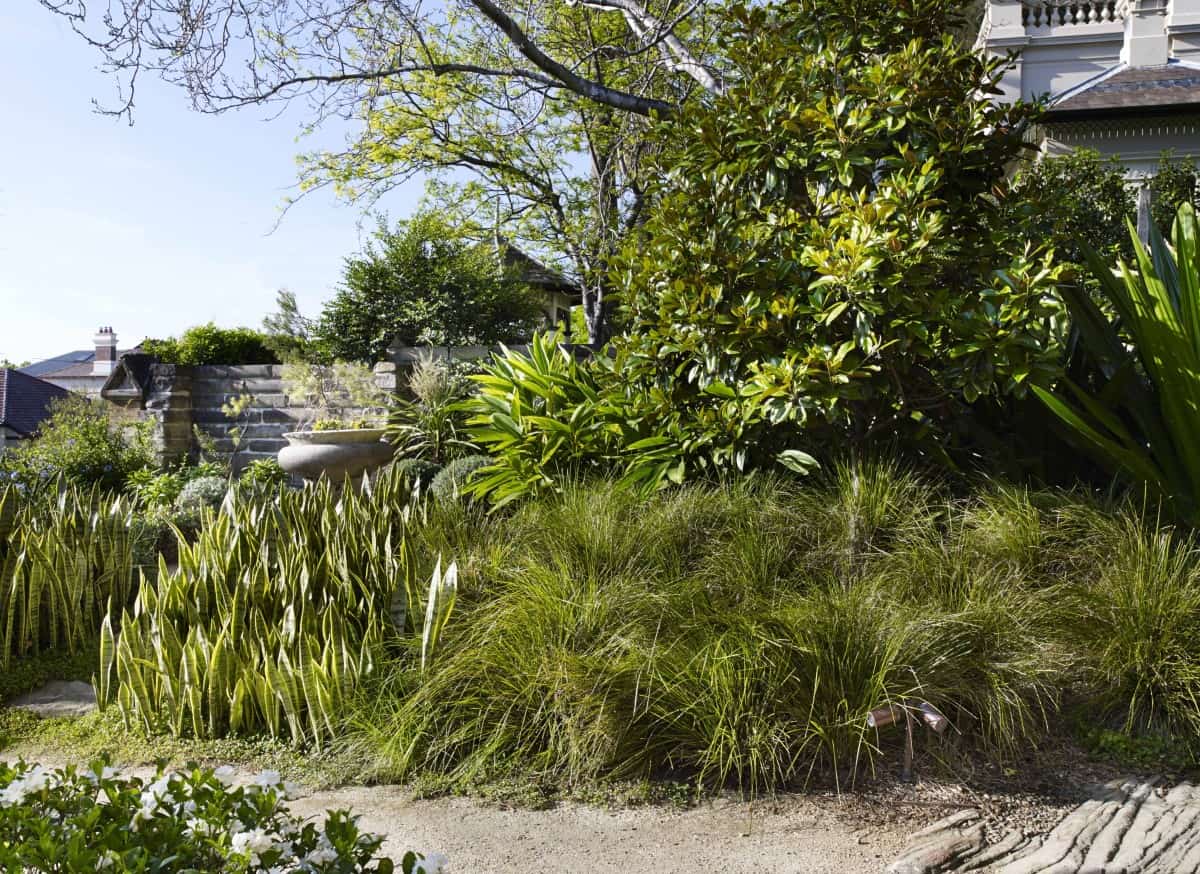
Location The Abbey | Designer Dangar Barin Smith | Photographer Prue Ruscoe
Lomandra is a genus of native Australian strappy or grass-like plants. Lomandra longifolia and the 50 other naturally occurring varieties thrive throughout Australia except for the Northern Territory.
A huge range of cultivars has increased the diversity of this exciting plant range and offer a wealth of variation in colour, form, and size to suit any garden.
Lomandra are typically very hardy and will tolerate most growing conditions from extreme wet to drought.
Lomandra are happy in full sun or shade and will cope with a wide range of soil types and pH levels. Lomandra typically from dense root systems that penetrate deep into the soil making them ideal for erosion control and steep banks.
The striking form of typical Lomandra varieties makes them ideal for accent plantings, mass plantings and as a special feature.
Lomandra are used by Indigenous Australians to create baskets hence the colloquial name, Basket Grass. Lomandra is also known as Spiny-head Mat-rush.
Lomandra – comes from the Greek, Loma, which means edge or border and andra, which means ‘man’. Longifolia – is derived from longi- (Latin) for ‘long’ and folia, which is Latin for ‘leaf’.
Varieties
Although Lomandra are highly versatile some species will do much better than others in specific climates and settings.
So, it’s important to think about how you want to use your Lomandra, the effect you’re looking for and, naturally the local soil and growing conditions.
Fortunately, with such an enormous range of Lomandra available to choose from you’re really spoilt for choice.
lomandra longifolia
Lomandra longifolia are known for their emerald green, flat leaf around 10mm wide, ending with several points at the tip. Their small, creamy-yellow flowers are slightly fragrant and appear in spring to early summer.
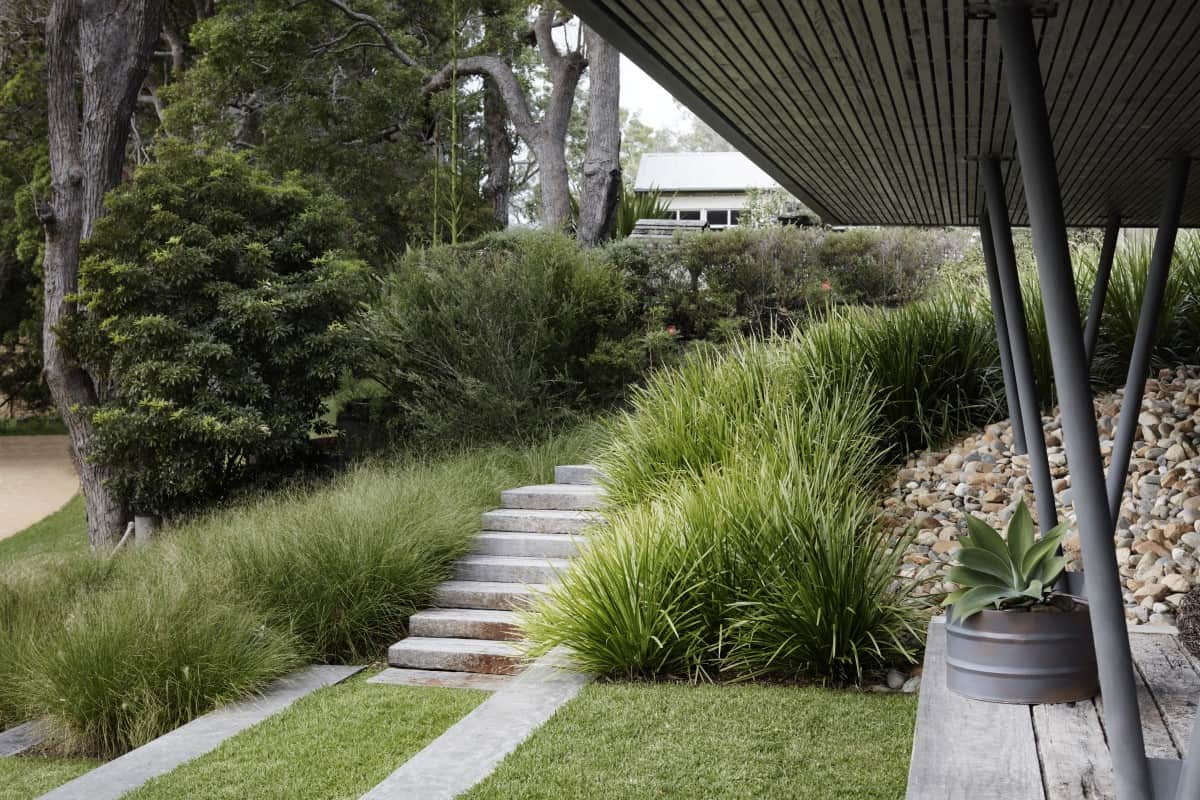
Lomandra “Katrinus” | Location Callala Bay | Designer Dangar Barin Smith | Photographer Prue Ruscoe
lomandra longfolia — ‘Katrinus Deluxe’
Katrinus Deluxe produces a stunning display of gorgeous yellow flowers that make a marvellous display when planted en masse.
Growing up to 70cm high, it is a compact plant with strappy evergreen leaves that are long enough to develop a slightly weeping habit.
Katrinus is ideal for erosion control as it will strengthen the soil stability by up to 366%.
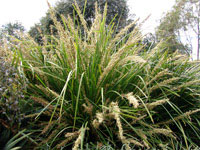
KATRINUS DELUXE
Lomandra longfolia‘Katrinus Deluxe’ ![]()
lomandra longfolia ‘LM300 Tanika’
Tanika has an established reputation as a super tough strappy landscaping plant that’s extremely drought resistant and yet is gorgeously soft to touch.
Long strappy leaves add a weeping appearance to its essentially upright growth habit. It’s low maintenance and produces small yellow flowers for 7 months of the year.
Growing up to 50 or 60cm high, it’s an ideal medium sized Lomandra for dry soil areas and slopes.
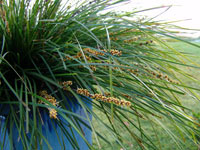
TANIKA®
Lomandra longfolia‘LM300’ ![]()
lomandra longifolia ‘MURU Great White’
Great White is dense compact plant that produces larger flowers than typical for Lomandra. It is similar to Katrinus Deluxe but with variegated leaves that provide an excellent contrast.
These strappy plants cope well in drought, cold, windy conditions. It will tolerate coastal conditions and is happiest in full sun to partial shade.
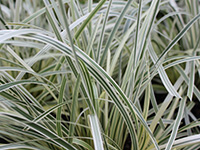
NEW GREAT WHITE™
Lomandra longifolia‘MURU’ ![]()
lomandra longfolia ‘LM400 Nyalla’
Nyalla is the toughest coastal Lomandra and will thrive in salty conditions. The finely textured, narrow-leaved evergreen blue grey foliage is complemented by small yellow flowers.
Its upright growth habit gives it a similar appearance to a grass tree but without the trunk. Tolerant of drought and cold, Nyalla loves full sun to partial shade.
Nyalla is a superb choice for erosion control. Growing up to 80 or 90cm high, Nyalla can make a spectacular specimen plant in a container.
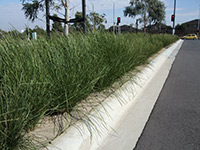
NYALLA®
Lomandra longfolia‘LM400’ ![]()
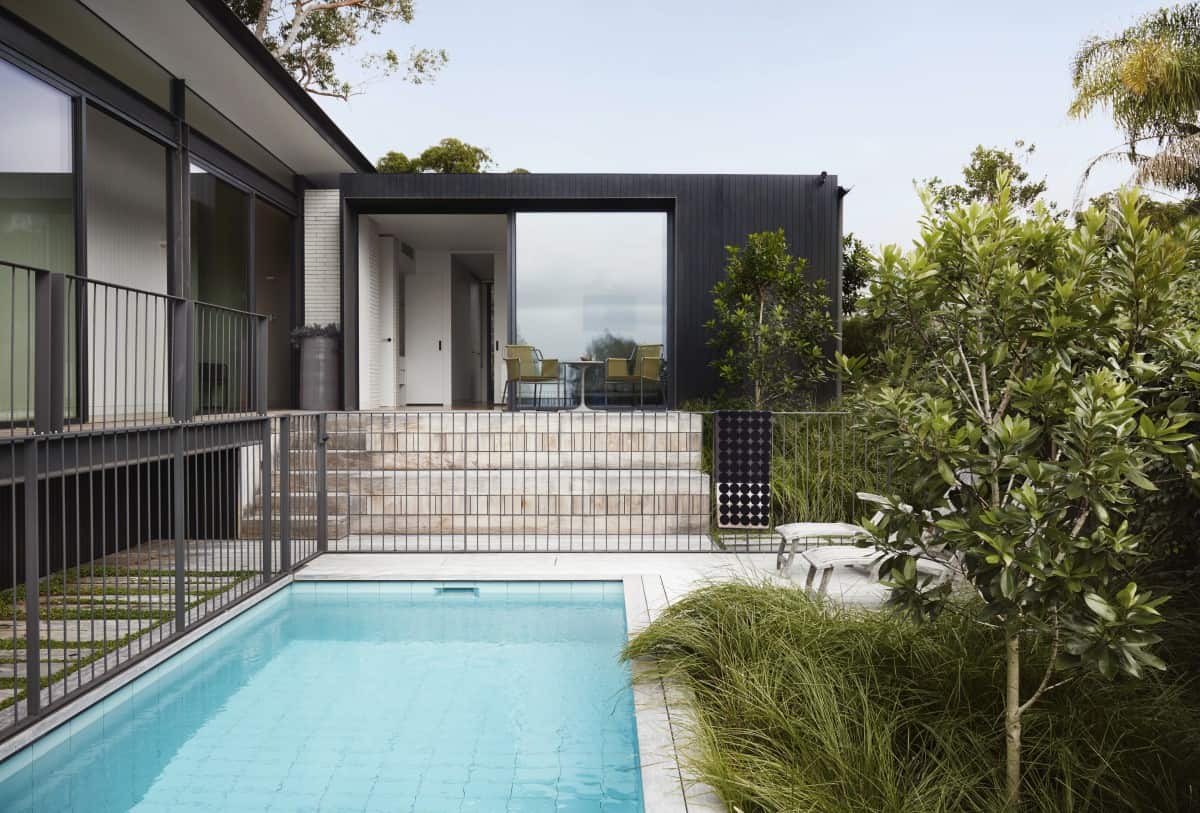
Lomandra “Tanika” | Location Callala Bay | Designer Dangar Barin Smith | Photographer Prue Ruscoe
lomandra longfolia ‘NPW3 Variegated Tanika’
This variegated version has many of the same wonderful qualities as Tanika but is a great choice for when you need eye-catching contrasting foliage.
It’s drought and frost resistant but doesn’t cope with wet feet. It’s also advisable to avoid planting it in areas exposed to hot drying winds.
You may need to prune it more than the standard Tanika to maintain the clean growth habit but the gorgeously soft contrasting foliage is worth any effort.

VARIEGATED TANIKA™
Lomandra longfolia‘NPW3’ ![]()
lomandra hystrix
Slightly slimmer strappy leaves to Lomandra longifolia, L. hystrix are found naturally occurring around freshwater lakes, rivers and streams, so require a little more irrigation than L. longifolia when planted in the landscape and handle humidity well.
lomandra hystrix ‘LHBYF Katie Belles’
Katie Belles is right at home in extreme dry and wet conditions.
This evergreen rain garden plant produces masses of stunning sweet perfumed yellow flowers from September to November and frequently again in autumn.
This large Lomandra (up 1.8m high) produces long, broad strappy leaves in a weeping habit. Katie Belles is great for erosion control and will enhance soil strength by up to 285%.
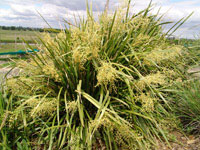
KATIE BELLES™
Lomandra hystrix ‘LHBYF’ ![]()
lomandra hystrix ‘LMV200 Lucky Stripe’
Lucky Stripe is a tough strappy leafed plant that retains its clean highly contrasting foliage year after year even in humid climates.
Its exceptional disease resistance ensures that spots and blemishes that affect other variegated plants remain absent from Lucky Stripe.
This makes it a great choice for gardens requiring contrast or for mass roadside plantings, green walls and in rain gardens.
Lucky Stripe grows to 1 m high and you’ll love the cream stripe running down the centre of the evergreen leaf.
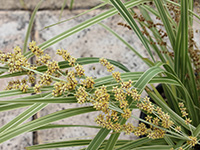
NEW LUCKY STRIPE™
Lomandra hystrix‘LMV200’ ![]()
lomandra hystrix ‘LHWP Tropic Cascade’
Luscious green weeping foliage and large highly perfumed yellow flowers create a beautiful mass planting display.
Cascade copes with most conditions including humid climates and wet soil. Growing up to 80cm tall, Tropic Cascade is a highly versatile plant that works perfectly in mass or specimen plantings in either residential or commercial sites.
You can maintain it as a smaller plant with regular pruning so even in smaller gardens it will provide a spectacular vision.
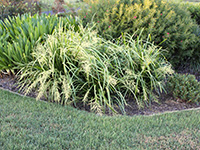
TROPIC CASCADE™
Lomandra hystrix ‘LHWP’ ![]()
lomandra filiformis
Commonly known as Wattle Matt Rush for its bright yellow, pom-pom wattle-like flowers in spring and summer. L filiformis has a finer leaf width, between 3-5mm so can handle much drier conditions than L. longifolia.
lomandra filiformis ‘LM500 Savanna Blue’
This is a small blue foliage Lomandra that grows to no more than 30 cm high making it ideal for ground cover or as part of a contrasting foliage display.
It provides great textural contrast and performs well in a range of conditions including wet and dry soil types although it prefers free draining soil.
It tolerates drought and frost really well too.
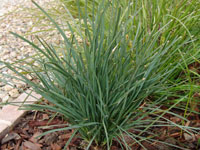
SAVANNA BLUE™
Lomandra filiformis‘LMF500’ ![]()
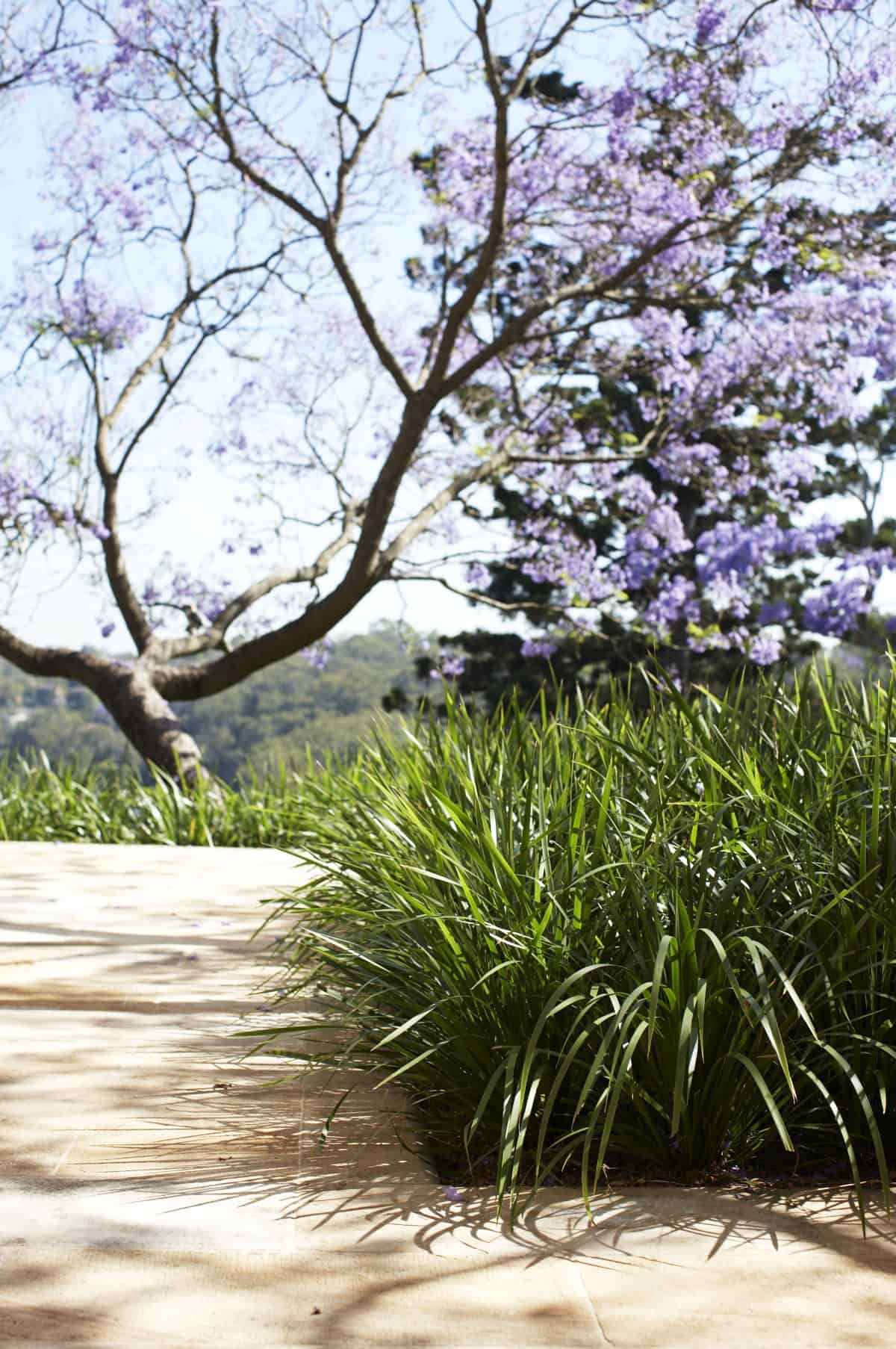
Lomandra “Katrinus” | Location House By The River | Designer Dangar Barin Smith | Photographer Anson Smart
lomandra multiflora
There hasn’t been a lot of breeding for commercial cultivation in this species. It can be broken into two sub species. L.multiflora sub species multiflora’s natural habitat can be found from Southern PNG to Western Melbourne while L. multiflora, sub species dura can be found in Southern SA only.
lomandra multiflora ‘VER1 Frilly Lace’
Evergreen foliage and an exuberant display of large yellow flowers make this one of the most colourful Lomandras.
Its upright clean and elegant foliage provides the perfect backdrop for the lacy flowers. This drought and frost tolerant plant makes a superb feature plant.
Growing up to 45cm high Frilly Lace will look equally impressive in containers or pots or as an impressive feature of massed plantings.
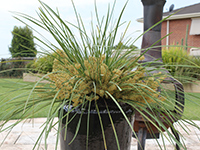
NEW FRILLY LACE™
Lomandra multiflora‘VER1’ ![]()
lomandra conferifloria
L. confertifolia are known for their striking grass tree-like clumping foliage. Unfortunately, they are slower to establish and they are temperamental in the garden, dying with little or no warning.
Our most successful L. confertifolia bred to date has been Wingarra, whose longevity can be attributed to its’ long rhizomes that deeply penetrate the soil.
lomandra confertifolia ‘SIR5 Wingarra’
The fine-textured blue-green foliage makes this one of the most grass like of the Lomandra family.
A compact clumping form and small yellow flowers make this ideal for cottage gardens or to recreate a Mediterranean planting style.
It features a strong clumping form and its deep rhizomes make it a much hardier than most of the confertifolia family. Growing to 30 cm high it will do well in pots or as a mass or border planting.

WINGARRA®
Lomandra confertifolia‘SIR5’ ![]()
lomandra fluviatilis
The L. fluviatilis is instantly recognisable by its fine, weeping foliage that is about 3-5mm wide and soft to touch – making it suitable for kid’s playgrounds.
It’s a tough, evergreen Lomandra, highly resistant to phythophthora, that suits many soil types and copes with periodic wet feet.
lomandra fluviatilis ‘ABU7 Shara’
Shara is a hardy fine-leafed Lomandra. The lusciously soft blue grey leaves provide a lovely contrast with the profusion of small yellow flowers.
It’s highly drought tolerant and very resistant to diseases including Phytophthora. Its small compact form (up to 55cm high) makes it a great choice for mass planting, ground cover or as a border.
Its deep rooting system also makes it a great choice for erosion control.
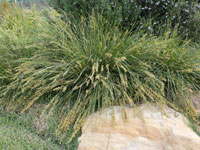
SHARA™
Lomandra fluviatilis ‘ABU7’ ![]()
lomandra labill
Fine, glossy leaves of L. labill can be found in every state and territory except WA and NT. The rich green foliage of this sub species of Lomandra longifolia make it a tough species that looks good year-round.
lomandra labill ‘LM600 Evergreen Baby’
Despite its fine evergreen foliage and small size this is a super hardy strappy plant that will cope well with drought and wet feet.
Beautiful golden flowers in spring complete the package and make this ideal for cottage gardens and border plantings. The flowers are sterile so you won’t have any problem with unwanted spreading.
Growing to just 45cm high, this is the perfect choice for low maintenance, no irrigation gardens or for those hard to fill wet areas.
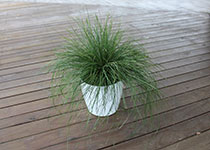
NEW EVERGREEN BABY™
Lomandra labill. ‘LM600’ ![]()
lomandra lime tuff (Mat Rush)
Lime Tuff is another hybrid that is proving popular. This is a medium sized plant with a very upright compact growth habit. The evergreen lime coloured flat leaves contrast nicely with the small yellow flower spikes.
Growers Guide
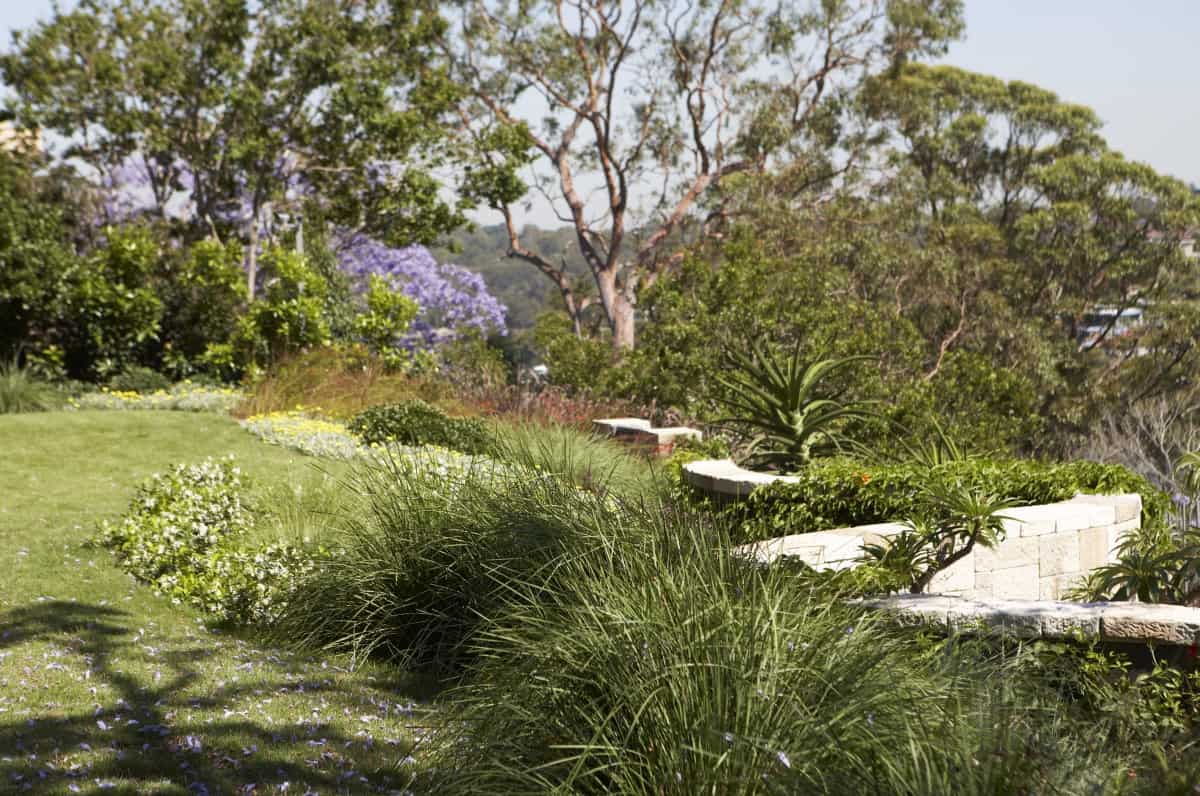
Lomandra “Tanika” | Location House By The River | Designer Dangar Barin Smith | Photographer Anson Smart
Soil Types
Lomandra longfolia varieties are generally speaking the most versatile as they will usually cope with a wide range of soil types from sandy soil to heavy clay.
Confertifolia varieties are usually slower growing and prefer slightly drier conditions. Hystrix varieties frequently do well in wetter humid conditions.
Most Lomandras will cope with a wide range of soil conditions from sandy soil through to clay type soils.
Although some Lomandras such as ‘Lucky Strike’, ‘Shara’ and ‘Evergreen Baby’ are happy in wet soils there are few Lomandras that will cope with permanently wet feet.
We’ve chosen Lomandra varieties that are highly disease resistant. This is particularly important in wetter areas where phytophthora can be a problem for less hardy species.
Nonetheless, you need to choose the right Lomandra for your location and needs. See below for recommended Lomandra species for your region.
Lomandras for dry parts of NSW:
Tanika®, Nyalla®, ‘Katrinus Deluxe’, Shara™ or Evergreen Baby™ are the best choice for those dry areas of NSW.
Lomandras for wet areas of NSW:
Evergreen Baby™, Shara™, Tropic Cascade™ or Katie Belles™ will cope better with the wet areas of NSW. Root rot can set in a cause Lomandras to fail if they suffer from really wet feet.
Lomandras for QLD:
Unless you live in the less humid parts of Queensland we recommend you use Evergreen Baby™, Shara™, Tropic Cascade™ or Katie Belles™.
Many of the dry loving Lomandras, although they’re highly resistant to phytophthora will struggle here.
Lomandras for VIC:
Tanika®, Nyalla®, ‘Katrinus Deluxe’, Shara™ or Evergreen Baby™ in drier, well-drained areas or Shara™, Evergreen Baby™, Southern Cascade™ or Katie Belles™ in wetter parts.
Lomandras for SA:
Tanika®, Nyalla®, ‘Katrinus Deluxe’, Shara™ or Evergreen Baby™ in drier, well-drained areas or Shara™, Evergreen Baby™, Southern Cascade™ or Katie Belles™ in wetter parts.
Lomandras for TAS:
Tanika®, Nyalla®, ‘Katrinus Deluxe’, Shara™ or Evergreen Baby™ in drier, well-drained areas or Shara™, Evergreen Baby™, Southern Cascade™ or Katie Belles™ in wetter parts.
Lomandras for WA:
Tanika®, Nyalla®, ‘Katrinus Deluxe’, Shara™ or Evergreen Baby™ in drier, well-drained areas or Shara™, Evergreen Baby™, Southern Cascade™ or Katie Belles™ in wetter parts.
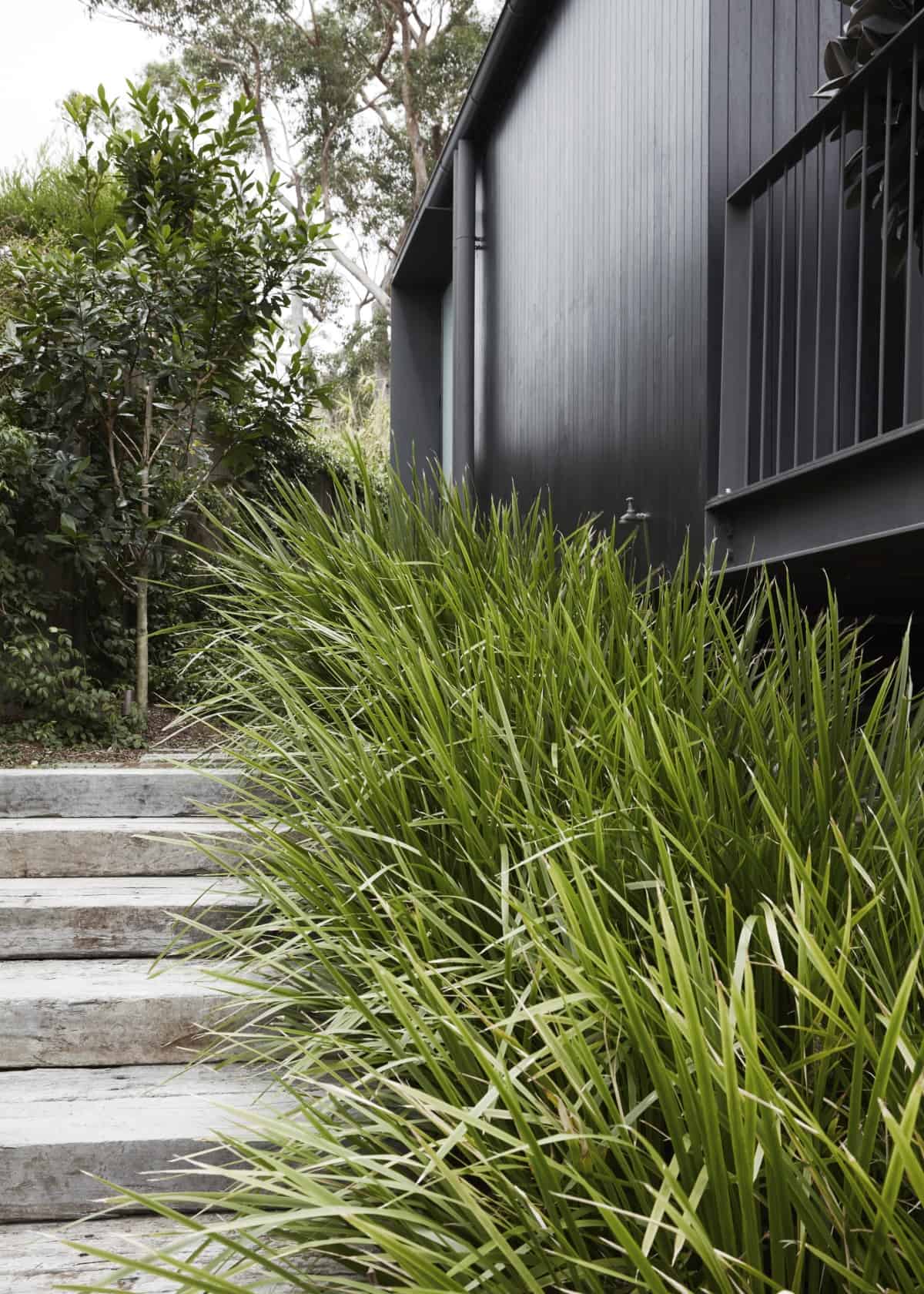
Lomandra “Katrinus” | Location Callala Bay | Designer Dangar Barin Smith | Photographer Prue Roscoe
Where to Grow
Lomandras, with their range of evergreen and contrasting strappy foliage are perfect for a range of garden and landscaping settings.
Think Mediterranean planting, cottage gardens and line of sight plantings where your eye will be naturally drawn to the rich array of texture, form, and colour.
The highly textured strappy leaves and compact forms make Lomandra a great choice for planting open areas en masse where the movement of the leaves in the breeze and the changing light of day make for a spectacular display. Think border plantings and ground cover.
Our range of Lomandras produce very clean foliage that requires minimal maintenance. These highly disease resistant varieties are not prone to the blemishing and spotting that many other strappy leaved plants display.
Most Lomandras are deep rooting and so make the perfect choice for erosion control, on top of retaining walls or bank plantings. Katie Belles or Katrinus Deluxe are particularly effective in this role. Research indicates soil retention is increased by as much as 366%.
Most of our Lomandra varieties produce sterile seed so they’ll stay where you put them. They mostly thrive on natural rainwater although may need some watering in severe droughts.
Their hardy no-fuss nature makes them ideal for low or no-maintenance plantings. The exception here is the slow growing confertifolia varieties which don’t compete well with weeds.
Height Guide
Lomandra species come in a wide variety of heights so there’s one for every garden setting.
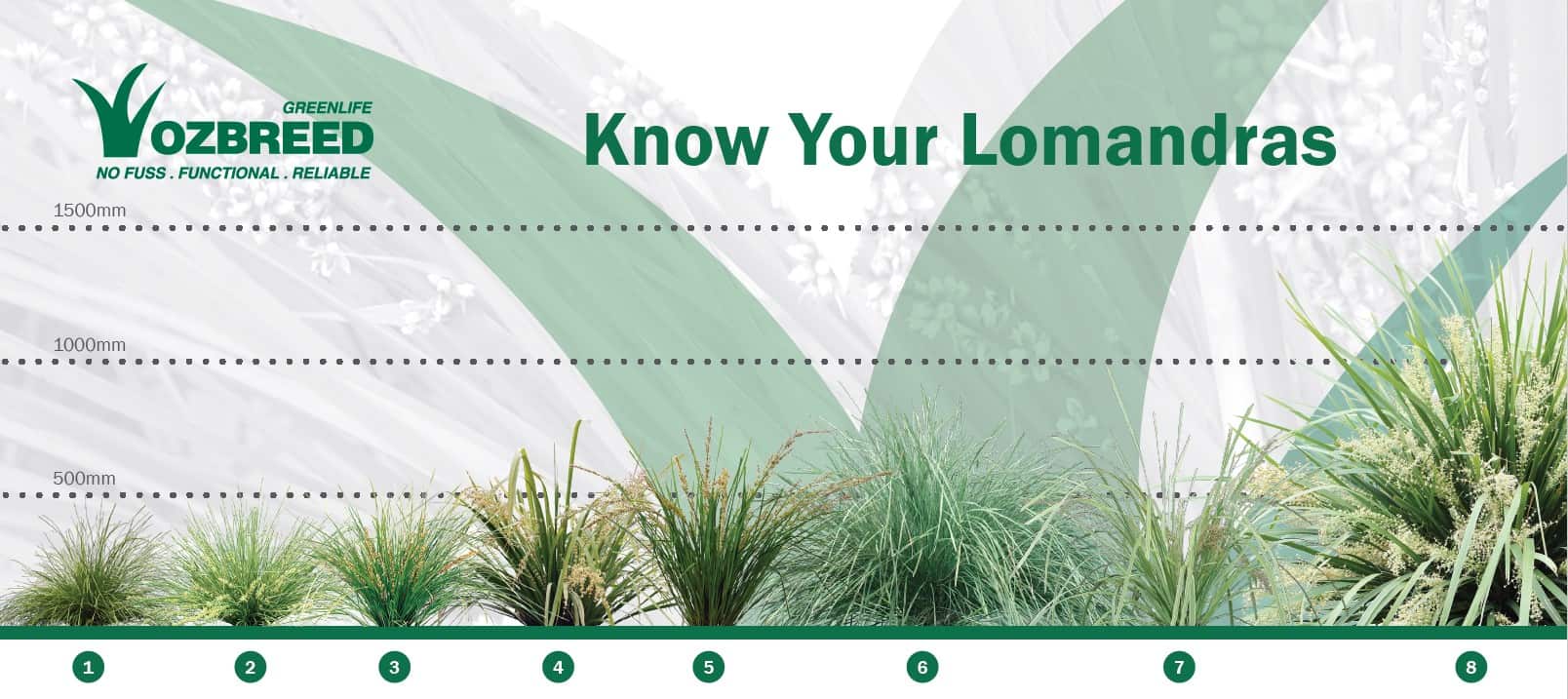
1. Evergreen Baby™ Lomandra labill. ‘LM600’ PBR
Tough, compact, fine leaf, wet feet & drought tolerant, 100% Phytophthora resistant (at time of printing).
40–45cm H x 45cm W
2. Shara™ Lomandra fluviatilis ‘ABU7’ PBR
Tidy, tough, compact, fine leaf, humidity & drought tolerant, 100% Phytophthora resistant (at time of printing).
55cm H x 50cm W
3. Tanika® Lomandra longifolia ‘LM300’ PBR
Reliable, tough, fine leaf, very drought tolerant, low maintenance, soft evergreen foliage.
50–60cm H x 65cm W
4. Tropic Cascade™ Lomandra hystrix ‘LHWP’ PBR
Compact weeping foliage, handles periodic wet feet, highly Phytophthora resistant, good erosion control option.
60–80cm H x 60-80cm W
5. Lomandra longifolia ‘KATRINUS DELUXE’ PBR
Clean growing, uniform, great erosion control plant, can survive on natural rain fall, frost & drought tolerant.
70cm H x 70cm W
6. Nyalla® Lomandra longifolia ‘LM400’ PBR
Toughest for coastal & salt laden winds, versatile, low maintenance, good erosion control, drought & cold tolerant.
80–90cm H x 80–90cm W
7. Lucky Stripe™ Lomandra hystrix ‘LMV200’ PBR
Reliable, tough, ultra clean variegated foliage, drought & humidity tolerant, long lived, highly Phytophthora resistant.
80cm–1m H x 90cm W
8. Katie Belles™ Lomandra hystrix ‘LHBYF’ PBR
Best performing, evergreen Australian native rain garden plant, drought, cold & coast tolerant, highly Phytophthora resistant.
1.5–1.8m H x 1.2–1.5m W
Getting the height right allows for layering plants to achieve a green wall and to ensure that flowers or contrasting foliage remains visible.
This is particularly important for low maintenance gardens where regular pruning is not an option.
Small Lomandras are 30cm to 50cm tall.
This is an ideal size for border plantings or compact areas such as cottage gardens where space is at a premium.
This smaller size works well as an accent plant too especially when grown in well-placed pots or containers.
These smaller plants can also create great layered contrast plantings when juxtaposed in front of larger Lomandras.
- Savanna Blue
- Wingarra
- Great White
- Frilly Lace
- Shara
- Evergreen Baby
Medium sized Lomandras are 50 to 90cm tall
This size Lomandra is ideal for specimen or mass plantings for commercial and residential use. They work brilliantly as border plantings alongside pathways or in containers.
These medium sized plants create an obvious impression without being too imposing or growing across pathways.
- Tropic Cascade
- Sungold
- Variegated Tanika
- Tanika
- Nyalla-
- Katrinus Deluxe
- Lime Tuff
Large Lomandras are 90cm to 1.8 m
These bigger sized Lomandras are perfect for large scale mass plantings alongside water courses or roadsides.
They work equally well as specimen plants, in rain gardens, or for planting out steep banks or to hide retaining walls.
- Katie Belles
- Lucky Stripe
Flowers
One of the special characteristics of Lomandras is the spiky flower head that produces masses of delicate yellow flowers, whilst the ‘Pacific Sky’ is particularly notable for its black flower stem and pale yellow flowers.
Many of the flowers are quite aromatic and will attract the bees. Some of the Lomandras are highly prolific flowerers and will provide a visual treat for many months.
Varieties with a strong highly perfumed flowering display such as Frilly Lace or Tropic Cascade really demand an obvious place as a feature planting.
They’ll also work equally well in a cottage garden setting, line of sight layout or in mass plantings.
Katrinus Deluxe and Great White produce larger sized flowers than is usual with Lomandras; these make a spectacular sight when planted en masse.
Dividing Lomandras
Thanks to its clumping form and rhizomes, Lomandras are easy to propagate by division.
You can simply dig up a healthy plant and divide the plant in half. Remove all the dead foliage and cut back the remaining foliage by half; this reduces transpiration stress on the plant.
Plant the two halves in moist soil.
 Todd Layt
Todd Layt
Todd was the author of Drought Tolerant Gardening Guide, 2009, ISBN; 978-0-646-50860-3. He has written for the Landscape Contractor and the Landscape Manager magazines for many years.
Todd has managed turf farms and a large production nursery for many years and is the director and owner of Ozbreed Pty Ltd, breeding many native and exotic plants.
Where to Buy
You can buy the Ozbreed range of Lomandras throughout Australia from recognised nurseries as well as online. You can find your most convenient supplier here.
Ozbreed and Lomandra – celebrate a wonderful Australian plant and make your garden special.
Video Guides
‘KATRINUS DELUXE’ Lomandra is a dense erosion control plant with masses of yellow flowers.
‘TANIKA® Lomandra longifolia LM300 PBR is a drought tolerant Lomandra which has been performing in landscapes across Australia for over a decade.
